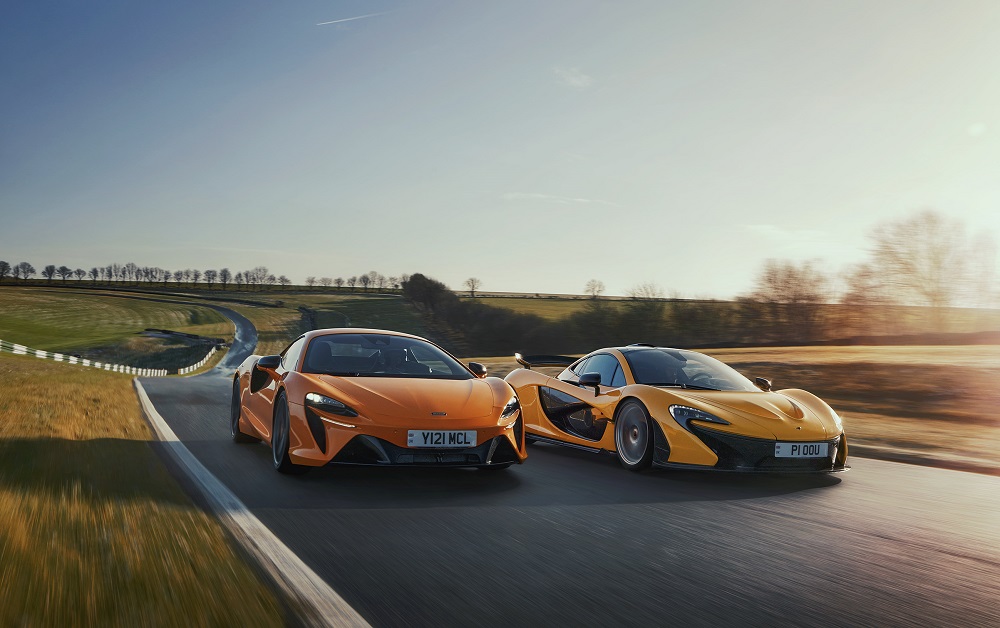McLaren is celebrating the 10-year anniversary of the reveal of the production version of the McLaren P1. Unveiled at the 2013 Geneva Motor Show, this remarkable hypercar is recognised as a landmark both for McLaren and the development of high-performance hybrid vehicles - showcased most recently by the all-new Artura.
Created with the intention of being
"the best driver’s car in the world on both road and track", the design
and technical specifications of the McLaren P1 provided the ideal
foundation to deliver on this ambition. A series of testing and
development achievements during 2013 - including lapping the famous
Nürburgring Nordschleife - immediately cemented the car’s credentials.
A
3.8-litre, twin-turbocharged M838TQ V8 engine developing 737 PS
combined with a lightweight electric motor producing 179 PS to give a
total of 916 PS. This delivered levels of performance that were - and
indeed remain - astonishing: acceleration from 0-100 km/h in 2.8
seconds; 0-200 km/h in 6.8 seconds and 0-300 km/h in 16.5 seconds - a
full five seconds quicker than the legendary McLaren F1. A maximum speed
of 350 km/h added to the appeal and reputation of the McLaren P1, but
it was the instant throttle response and torque infill that conclusively
proved that electrification could truly enhance modern turbocharged
powertrains.
Alongside a benchmark hybridised, petrol-electric
powertrain, the Ultimate hypercar was underpinned by two of McLaren’s
trademark strengths - low vehicle weight and aerodynamic excellence.
The
MonoCage carbon fibre monocoque with roof at the core of the McLaren P1
was a development of the MonoCell structure used in McLaren’s 12C
supercar and key to optimising mass in a vehicle with a dry lightest
weight of just 1,395 kg. DIN weight was 1,490 kg.
The relentless
pursuit of light weight remains a priority for McLaren and in 2023 the
new Artura - also a high-performance hybrid, but a generously equipped
series-production supercar rather than an extreme, limited-edition
hypercar - has a DIN weight of 1,498 kg.
The carbon fibre body
panels of the McLaren P1 comprise a large clamshell; single-moulded
front and rear panels attached to the central MonoCage; two small access
flaps in the rear; a front bonnet and the two doors. Weighing a total
of only 90 kg, the panels are extraordinarily thin but also very strong.
The hybrid battery, which is mounted low inside the carbon fibre
MonoCage, weighs just 96 kg. Again, this philosophy of minimising weight
is evident in the present day, with similar attention strategies
applied in the Artura.
The McLaren P1 had no floor carpet - it
was deemed unnecessarily heavy - and no sound deadening. The glass was
re-engineered to reduce weight - the super lightweight roof glass is
chemically toughened, and only 2.4mm thick. The windscreen is just 3.2mm
thick, including a plastic interlayer, saving at the time 3.5 kg over
the 4.2mm-thick screen of the 12C.
The large rear wing of the McLaren P1 optimises aerodynamics by adjusting automatically. It can extend rearwards by up to 300mm on track and 120mm on road. This was developed using the same software and methodology as the McLaren Formula 1 team. A DRS (Drag Reduction System) was integrated into the design of the McLaren P1 to reduce downforce and increase straight-line speed, achieved through the pitch of the rear wing, rather than by using a removable flap.
A combination of CFD (computational fluid dynamics) aerodynamic modelling and many hours spent in a wind tunnel focusing on aerodynamic performance, resulted in downforce of 600 kg at well below maximum speed.
Extremely
exclusive and highly desirable from the moment it was revealed, the
McLaren P1 sold out within mere months of reveal and by November all 375
cars were allocated. Build of the first of the 375 McLaren P1
production models - finished in Ice Silver paintwork - finished in
September 2013 - by which time it had become firmly established as a
performance icon. The final customer-ordered car was completed in
December 2015; it was painted in a stunning pearlescent orange, a colour
achieved through a unique tinting process that became available in
other McLaren models as Volcano Orange.
Ten years after its
Geneva Motor Show appearance - and in the year that McLaren also
celebrates the 60-year anniversary of Bruce McLaren founding the company
- the McLaren P1 remains an incredibly exciting and dynamically
accomplished performer on both road and track.
The enduring
legacy of the P1 extends beyond its iconic status in McLaren’s lineage
of technologically advanced, driver-focused cars. As a precursor of
electrification as an enhancement to driving engagement it changed
perceptions of the technology, inspiring the ground-breaking Artura; a
supercar that blends thrilling performance and driving dynamics with EV
driving capability - a winning combination pioneered by the McLaren P1.























